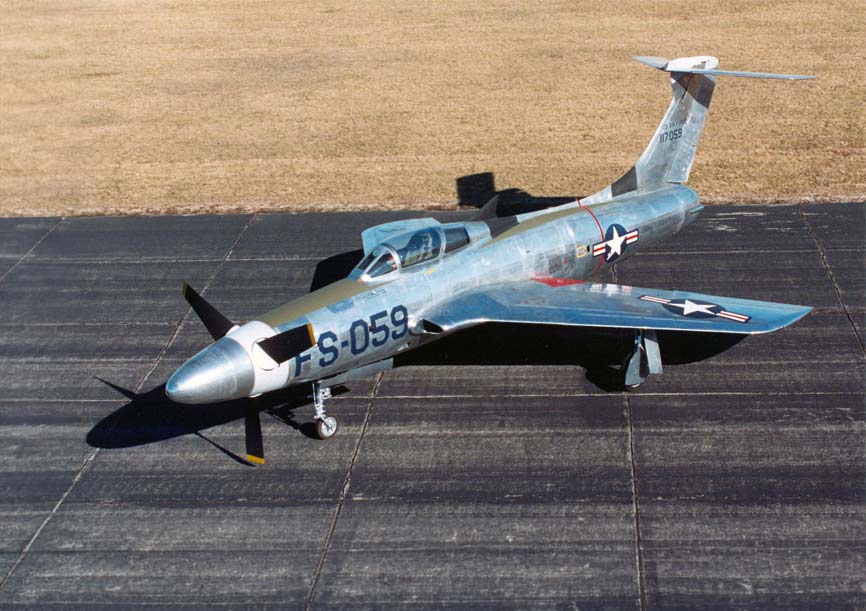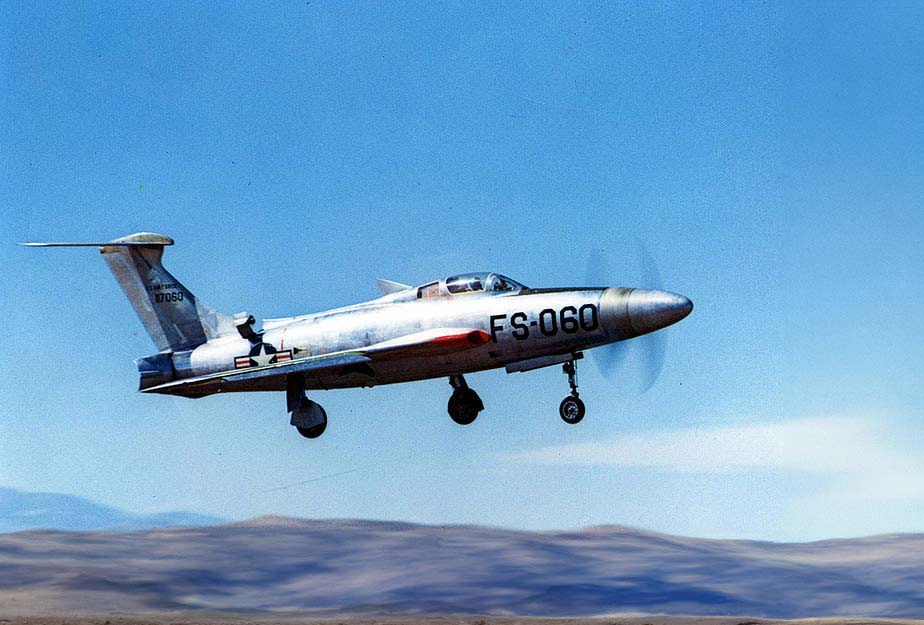The XF-84H Thunderscreech is an experimental supersonic propeller-driven fighter derived from the F-84F Thunderstreak.
In brief
The Republic XF-84H Thunderscreech, developed from the F-84F Thunderstreak, was an experimental turboprop aircraft known for its incredibly loud supersonic propeller. First flown in 1955, it aimed to set speed records for propeller-driven aircraft, with a projected speed of Mach 1.18. However, the XF-84H was plagued by aerodynamic and engine reliability issues, leading to its program’s cancellation. Despite its potential, it gained notoriety for being one of the loudest aircraft ever built, causing discomfort and sickness among ground crews.
The Republic XF-84H Thunderscreech was an audacious attempt at creating a high-speed propeller-driven fighter aircraft during the 1950s.

History of Development
In the 1950s, the quest for speed and performance in aviation reached new heights. The United States Air Force, seeking to explore the limits of propeller-driven aircraft, initiated the development of the Republic XF-84H Thunderscreech. This experimental aircraft was a product of its time, representing the ambition to push the boundaries of speed while still employing a propeller-driven design.
The XF-84H was developed by Republic Aviation, known for their F-84 Thunderjet series. The concept was to create an aircraft that could achieve supersonic speeds using a turboprop engine, a radical idea at the time. The program was a response to the evolving needs of high-speed, high-performance military aircraft in the Cold War era.
The first flight of the XF-84H took place on July 22, 1955. However, the aircraft quickly gained a reputation for being problematic. Its supersonic propeller created an unbearable noise level, reportedly heard from miles away, leading to its nickname “Thunderscreech.” The noise was so intense that it caused physical discomfort and sickness among ground crews and was a significant hazard.
Despite the ambitious goals, the XF-84H faced numerous challenges. The aircraft was unstable in flight due to the powerful torque generated by the propeller. Additionally, the engine was temperamental and required a lengthy warm-up period, making it impractical for combat situations. These issues, combined with the unbearable noise, led to the eventual cancellation of the program in 1956.
The XF-84H Thunderscreech’s development is a fascinating chapter in aviation history, highlighting both the innovative spirit of the era and the practical limitations of technology at the time.
Design
The Republic XF-84H Thunderscreech was a unique aircraft in both its appearance and engineering. It measured 51 feet 5 inches (15.67 meters) in length, with a wingspan of 33 feet 5 inches (10.18 meters) and a height of 15 feet 4 inches (4.67 meters).
The aircraft was powered by an Allison XT40-A-1 turboprop engine, capable of producing 4,360 kW (5,850 hp) of power. This engine was connected to a supersonic propeller via an extension shaft, spinning faster than the speed of sound. The XF-84H’s propeller was one of its most distinctive features, as it was the source of the aircraft’s incredible noise and the primary contributor to its instability.
One of the design challenges was managing the torque produced by the supersonic propeller. This led to the incorporation of a T-tail configuration to keep the horizontal tail surfaces in clean airflow, away from the propeller’s turbulent wake. However, the design was not enough to mitigate the destabilizing effects of the propeller torque fully.
The aircraft also featured a retractable and extendable ram air turbine, a novel addition that provided electrical and hydraulic power in case of engine failure. This feature was indicative of the experimental nature of the XF-84H and its role as a testbed for new technologies.
Despite these innovative design elements, the XF-84H was plagued with issues. The powerful vibrations caused by the propeller shaft at high speeds and the need for a 30-minute engine warm-up period made the aircraft impractical for operational use. Furthermore, the intense noise generated by the supersonic propeller presented a significant challenge for both pilots and ground crews.
The design of the Republic XF-84H Thunderscreech was a bold experiment in aviation, pushing the limits of propeller-driven aircraft. However, the drawbacks of its design ultimately outweighed its innovative features, leading to the cancellation of the program.
Performance
The performance of the Republic XF-84H Thunderscreech was a mixed bag of extraordinary potential and significant challenges. The aircraft’s projected speed was Mach 1.18, an ambitious target for a propeller-driven fighter. However, in practice, the Thunderscreech struggled to achieve these speeds. The fastest recorded speed of the XF-84H was around 520 mph (840 km/h), making it one of the fastest single-engine propeller-driven aircraft until 1989.
In terms of altitude and range, the XF-84H was capable of impressive feats. The aircraft had a service ceiling above 40,000 feet and a range of approximately 2,000 miles, thanks to its powerful Allison XT40-A-1 turboprop engine.
Despite these promising specifications, the XF-84H’s performance was severely hampered by its design flaws. The aircraft was notoriously difficult to control due to the immense torque generated by its supersonic propeller. This instability led to several forced landings and a general reluctance among test pilots to fly the aircraft. In fact, one of Republic Aviation’s test pilots, Lin Hendrix, refused to fly it again after just one flight.
The Thunderscreech’s engine also presented problems. Its lengthy warm-up time and reliability issues made it unsuitable for combat or rapid deployment scenarios. Additionally, the noise generated by the aircraft was not just an inconvenience; it was a significant health hazard for those in close proximity.
When compared to its contemporaries, the XF-84H was an outlier. Its attempt to combine turboprop speed with jet-like performance was unique, but the practical challenges it faced made it less competitive than more conventional jet fighters of the era.
Variants of the Republic XF-84H Thunderscreech (300 words)
The Republic XF-84H Thunderscreech was produced in only two prototypes, each with its unique set of characteristics and performance outcomes.
- Prototype 1 (Serial Number 51-17059): This prototype achieved a total of eleven flights, but ten of these ended in forced landings due to the aircraft’s instability and engine problems. It was later restored and displayed at the National Museum of the United States Air Force at Wright-Patterson Air Force Base in Dayton, Ohio.
- Prototype 2 (Serial Number 51-17060): This prototype managed only a single flight before being grounded. It faced similar issues as the first prototype, including instability and engine-related challenges. This prototype was assumed to have been scrapped following the cancellation of the program.
These prototypes represented the entire production run of the XF-84H Thunderscreech, with no further variants or production models developed due to the program’s early termination.

Military use and combat of the Republic XF-84H Thunderscreech
The Republic XF-84H Thunderscreech was never used in military combat or operational scenarios. Its role was purely experimental, serving as a testbed for high-speed propeller-driven aircraft technology. The development and testing of the XF-84H were conducted under the auspices of the United States Air Force’s Propeller Laboratory at Wright-Patterson Air Force Base.
The primary objective of the Thunderscreech program was to explore the limits of propeller-driven aircraft speed and performance. However, the significant challenges and risks associated with the aircraft, including its extreme noise, engine reliability issues, and flight instability, prevented it from being considered for any combat or operational use.
The XF-84H’s armament capabilities were not a focus of its development, as the aircraft was intended primarily for speed and performance testing. Therefore, it was not equipped with weapons systems or tested in any combat simulations.
Given its experimental nature and the problems encountered during testing, the XF-84H Thunderscreech was never sold to other countries or adopted by any military forces outside of the United States. Its service life was short-lived, with the program being officially canceled by the USAF in September 1956.
The Republic XF-84H Thunderscreech stands as a remarkable yet ultimately unsuccessful experiment in aviation history. Its attempt to push the boundaries of propeller-driven aircraft speed was ambitious but ultimately flawed due to the significant challenges it faced. While it never achieved its full potential, the Thunderscreech’s development provided valuable insights into the limitations of propeller-driven aircraft technology and remains a fascinating chapter in the annals of experimental aviation.
Back to the experimental aircraft section.